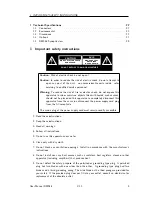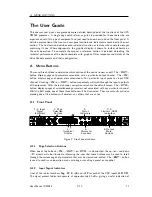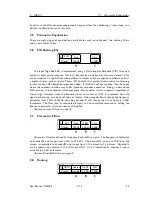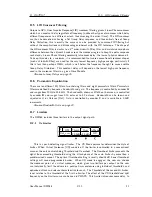
3
INTRODUCTION AND KEY FEATURES
3.3
Drive Modules
3.3
Drive Modules
The DMS48 processor has a new way of ordering and grouping channels in order to give a
more speaker based approach to controlling, designing and recalling speaker configurations;
these are called Drive Modules. A Drive Module is the Processing provided by one Input DSP
Block, and a number of Output DSP Blocks, which are associated with one-another by means
of routing. For example, if Input DSP Block B is routed to Outputs 3 and 4, then this is a
2-way Drive Module with Input DSP Block B forming the Master control, and Output DSP
Blocks 3 and 4 providing the driver-related control. Overall, this forms the control typically for
one loudspeaker sub-system. The PWAPG Drive Module control panel for this sub-system may
then be used for control and monitoring. The Presets in the DMS48 are Drive-Module centric,
and are used to configure individual Drive Modules rather than the whole device. Importantly,
Drive Modules move the focus away from the processing device, and onto the loudspeaker
systems.
3.4
LIR Linear Phase Crossover Filtering
The DMS48 also includes a new type of crossover filtering Linea Impulse Response (LIR)
crossover filtering, which gives a Linear Phase crossover that has a constant delay regardless
of frequency (unlike other types of crossover which delay different frequencies to a different
extent, thus smearing the arrival time). The LIR crossover can thus be described as having
a flat Group Delay response, and thus entirely free of Group Delay Distortion. The shape of
the LIR crossover filter is quite similar to a 4
th
order or 24dB/Oct Linkwitz-Riley filter, and
maintains zero phase difference between the adjacent bands across the crossover region to
keep the polar response rock steady. See illustration 1.
6
0
-6
-12
-18
-24
-30
-36
1 kHz
Frequency
100
10kHz
24 dB/octave
Figure 1: LIR Filter
3.5
FIR Linear Phase Equalisation
The Input High-Shelf Equalisers use Finite Impulse Response (FIR) filtering to produce Linear
Phase equalisation; that is all frequencies are delayed by the same amount, perfectly preserving
the transient response. This can also be important in applications where different amounts of
EQ are applied to different parts of a speaker cluster, such as to add ’Throw’ EQ boost so
that parts of cluster which are throwing further can have HF absorption correction added. If
User Manual DMS48
V1.1
9
Summary of Contents for DMS48
Page 1: ...User Manual Digital Processor DMS48...
Page 2: ......
Page 29: ......
Page 30: ......
Page 31: ......










































